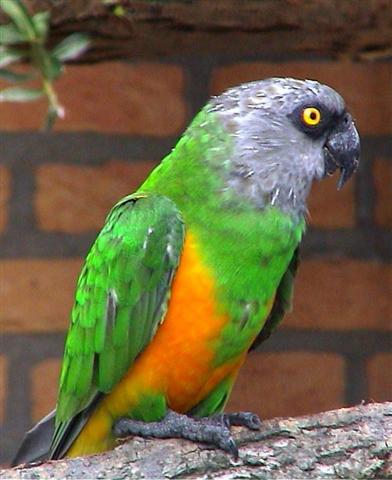Senegal Parrot
Scientific Name: Poicephalus senegalus
Fri, 1st November, 2024 - 6:31 am GMT
Sponsor Ads:

Alternative Name
Scientific Name: Poicephalus senegalusBasic Info
At maturity, Senegal Parrots are usually eight to nine inches in length. They have bright yellow eyes. The heads and necks are generally dark gray to black, as are their wings. The breasts of Senegal Parrots are green, orange, and yellow and have a yellow V shaped pattern, which can extend down into the abdominal area. This is known as the vest. There are three subspecies of Senegal Parrots, P. s. senegalus, P. s. versteri, and P. s. Mesotypus, respectively, the nominate, red bellied, and orange bellied. These subspecies all differ in appearance as well as their natural habitat preferences. The nominate has a yellowish orange to yellow-green chest pattern, the mesotypus has a flat, burn orange colored chest pattern with yellow under the wings and paler green on the body, and the red bellied is yellow under the wings and has deep, reddish-orange on the front of the belly. The distribution of P.s.s is: Senegal, Gambia, Guinea-Bissau and Guinea, P.s.m is: eastern and north east Nigeria, northern Cameroon and southwest Chad, and P.s.v is Ivory Coast and Ghana east to Western Nigeria.
Health
When kept in outside areas, Senegal Parrots should be offered some sort of shelter or indoor area. Aviaries of six feet by six feet by three feet may work well. If kept indoors, many people prefer that they be placed in a cage whose dimensions are at least four feet by three feet by three feet. Breeding DNA sexing is the most reliable way to sex Senegal Parrots. Visually, the heads and beaks tend to be smaller and sleeker in females than in males. Also, the V shaped vest sported by females tends to be much longer than that of the male, which terminates midway down the chest. This may not apply to all birds. Finally, a mature Senegal cock's under tail coverts are pure yellow, while the hen and the juvenile have yellow-and-green feathers. Generally, female Senegal Parrots reach sexual maturity at one to two years of age, and males follow at three years. Usually, they are not bred until they are three or four years old. Breeding season usually occurs between November and March, although breeding may occur year round. A nesting box should be provided, preferably one of 20 by ten by two inches. If your birds do not breed, you may wish to try changing the shape of the nesting box. Two to six eggs are laid at two-day intervals. The incubation period is about four weeks, and the chicks are usually ready to leave the nest when they are nine weeks old. By 12 weeks of age, young Senegal Parrots are usually completely independent.Habitat
They are generally found in the edges where wooded areas meet savannah or grassland areas.Behavior
As a sweet and cuddly bird, the Senegal Parrot makes a favorite pet to many people. These darling talking parrots are a sweet surprise to all who discover them! In captivity, these lovely little birds are quiet but will learn to imitate both noises and speech. They love playtime and being let out of their cages. Some individuals may bite when they are upset or frustrated. Senegal Parrots are generally one-person birds, and are usually very affectionate and love to cuddle. In captivity, they are usually fed a good seed or pellet diet, supplemented with fresh fruits and vegetables and are sometimes given lean cooked meat or pet biscuits as treats. They do well in medium sized cages as long as they are given plenty of time out of their cages to play and exercise. They are generally described as behaving like "big birds" or being calmer than smaller varieties of parrot. Senegal Parrots are highly intelligent and, although some individuals may be a bit more excitable than others, most are quite calm. The average lifespan of the Senegal Parrots is between 20 and 30 years, though individuals can live much longer with proper care.Origin
AfricaHistory
In some areas, Senegal Parrots are considered a nuisance because they have tendencies to raid farmers' crops. They steal peanuts and corn. Native to north central Africa, the Senegal Parrot makes a popular pet in the United States and Europe, where they were heavily imported until 1992. After importation became illegal, Senegal Parrots personalities began to improve through captive breeding and hand raising practices.Common Foods
In the wild, Senegal Parrots eat fruits, seeds, and grains.Sponsor Ads:
"I will speak daggers to her, but use none". -- Hamlet Act III, Sc. II, William Shakespeare
Senegal Parrot
Coded by: BGID® | ALL RIGHTS RESERVED Copyright © 2000-2024
Disclaimer | Privacy | Report Errors / Contact | Credits
















